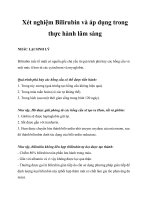Nhu cầu về dữ liệu lớn trong thực hành lâm sàng góc nhìn từ bác sỹ tim mạch
Bạn đang xem bản rút gọn của tài liệu. Xem và tải ngay bản đầy đủ của tài liệu tại đây (4.22 MB, 38 trang )
Big Data:
Perspective from Cardiology
A/Prof (Adj) Yeo Khung Keong, MBBS, FAMS, FACC, FSCAI
National Heart Centre Singapore
Disclosures
•
•
•
•
•
2
Abbott Vascular: Speaker, Proctor (MitraClip)
Boston Scientific: Consultant, honorarium
Philips: Honorarium
Medtronic: Research support
St Jude Medical: Speaker, honorarium
What is Big Data?
•
•
•
•
•
•
HUGE data volume
Clinical
Administrative data
Genetics/Genomics/metabolomics…..
Imaging
SPEED
What’s the Big Deal?
• New medical discoveries
• Improved ability to predict cost, outcomes
• Policy and planning
– Manpower
– Resources
– Budgeting
• Management of epidemic and outbreaks
• Pragmatic Research trials
D ATA A N D T E C H N O L O G Y H AV E T R A N S F O R M E D F I N A N C E
Human Model
Expert Model
Early 1900-1995
1995 - Current
Big Data Model
Trending
Healthcare is at the beginning of a necessary transformation.
6
7
“The future of precision medicine will enable health care
providers to tailor treatment and prevention strategies to
people’s unique characteristics, including their genome
sequence, microbiome composition, health history, lifestyle,
and diet. To get there, we need to incorporate many
different types of data, from metabolomics (the chemicals in
the body at a certain point in time), the microbiome (the
collection of microorganisms in or on the body), and data
about the patient collected by health care providers and the
patients themselves. Success will require that health data
is portable, that it can be easily shared between providers,
researchers, and most importantly, patients and research
participants.”
8
Key words
“The future of precision medicine will enable health care
providers to tailor treatment and prevention strategies to
people’s unique characteristics, including their genome
sequence, microbiome composition, health history,
lifestyle, and diet. To get there, we need to incorporate
many different types of data, from metabolomics (the
chemicals in the body at a certain point in time), the
microbiome (the collection of microorganisms in or on the
body), and data about the patient collected by health
care providers and the patients themselves. Success
will require that health data is portable, that it can be easily
shared between providers, researchers, and most
importantly, patients and research participants.”
9
10
UK Biobank: 500,000 patients
11
Benefits: New Medical Discovery
Genomic data!
May 2016 NEJM
Registry Based RCT
14
Registry Based RCT
• Enrollment from national SCAAR registry
• Endpoints from national registries
• 7244 patients!!
15
Quality Improvement
16
RIKS-HIA Quality Index
RIKS-HIAs Quality index summarizes
the quality of care at a hospital by using
9 different quality indicators
Quality indicators
0,5 point
1 point
Reperfusion in STEMI/LBBB
80%
85%
Reperf. within recommended
time in STEMI/LBBB
75%
90%
Angiography in target group of
NSTEMI patients
75%
80%
LMWH/ Heparin/ Fondaparinux
in NSTEMI patients
90%
95%
Aspirin in AMI patients
90%
95%
P2Y12-rec blocker in NSTEMI
patients
85%
90%
Beta-blocker in AMI patients.
85%
90%
Statin in AMI patients.
90%
95%
ACE-inhibitors/ARB in target
group of AMI patients.
85%
90%
2005
RIKS-HIAs Quality Index
2005
2011
30 day mortality after acute MI in Sweden vs. UK
Chung et al. Lancet. 2014; 383:1305-12.
Comparison of short-term outcome after acute myocardial infarction
Chung et al. Lancet. 2014;
383:1305-12.
4-country comparison – Stable Post-MI patients
All-cause death
MI/stroke/all-cause death
Observed risk (%)
50
Observed risk (%)
50
Sweden 20.1 (19.7–20.4)
USA 30.2 (29.8–30.7)
England 13.7 (12.6–14.8)
France 14.3 (12.5–16.1)
40
30
40
30
20
20
10
10
0
0
0.0
0.5
1.0
1.5
2.0
Sweden 26.9 (26.5–27.2)
USA 36.2 (35.7–36.6)
England 24.1 (22.7–25.5)
France 17.9 (16.0–19.8)
2.5
3.0
0.0
0.5
Follow-up (years)
1.0
2.0
2.5
3.0
2.5
3.0
Follow-up (years)
Adjusted risk (%)
Adjusted risk (%)
20
30
Sweden 11.2 (10.9–11.5)
USA 12.8 (12.3–13.4)
England 8.7 (6.9–10.5)
France 12.4 (10.1–14.7)
15
1.5
Sweden 19.8 (19.4–20.2)
USA 18.2 (17.6–18.9)
England 21.3 (18.2–24.2)
France 16.7 (14.3–19.2)
25
20
15
10
10
5
5
0
0
0.0
0.5
1.0
1.5
2.0
Follow-up (years)
2.5
3.0
0.0
0.5
1.0
1.5
2.0
Follow-up (years)
Hemingway et al. ESC Congress 2014, Registry Hot Line Session
What has been done?
Clinical/Admin
• USA
– ACC-NCR
– CMS data
– VA-CART
• Europe
– SwedeHeart
• Singapore
– SingCLOUD
Genomics
• Iceland: NEXTCODE
• China:
• UK: Biobank
• USA:
Asia
> 4 billion population
23
Opportunities
•
•
•
•
•
Asia: disparate, ginormous, young
If only…..
We had money
We worked together
We had the proper governance
Challenges
• Legal
• Risks
– Patient confidentiality and privacy
– Real patient hard
• Governance
– Who owns the data
– What about algorithms









